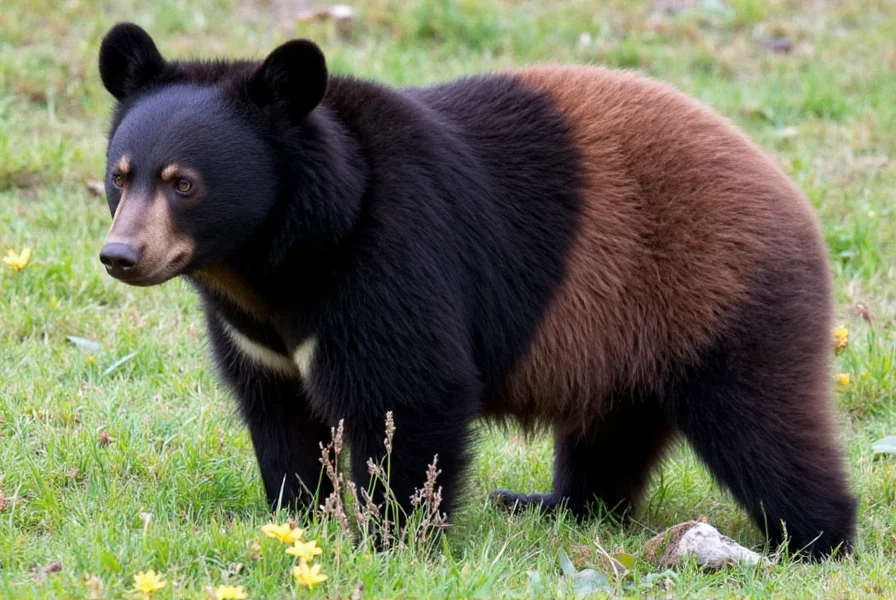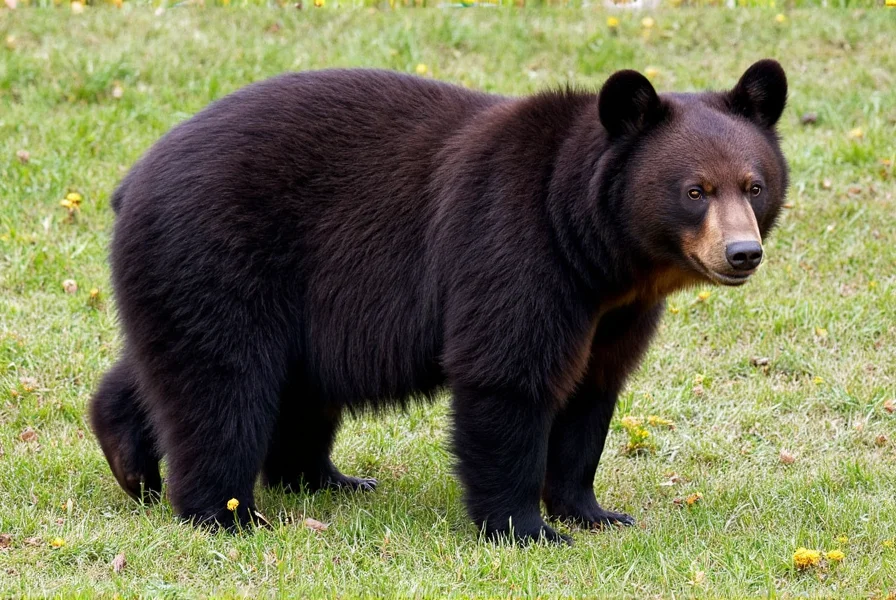A cinnamon bear is not a separate species but a distinctive color phase of the American black bear (Ursus americanus) characterized by its reddish-brown or cinnamon-colored fur. This genetic variation occurs across North America, particularly in western regions, and represents one of several possible coat colors for black bears, which can range from black to blonde. Despite common misconceptions, cinnamon bears are not related to grizzly bears, though their similar coloring sometimes causes confusion among wildlife observers.
The cinnamon bear represents one of the most visually striking variations within the American black bear population. This color phase gets its name from the distinctive reddish-brown hue that resembles ground cinnamon, though the exact shade can vary from light tan to deep reddish-brown. Understanding this unique variation requires examining both the genetics behind coat coloration and the ecological factors that influence its distribution across North America.
Genetic Basis of Cinnamon Coloring
Unlike what many assume, the cinnamon color phase results from specific genetic variations within the American black bear population. Research shows that a single recessive gene controls this distinctive coloring, explaining why two black-colored parents can produce cinnamon-colored offspring. This genetic trait appears most frequently in western populations of American black bears, particularly in regions spanning from the Rocky Mountains to the Pacific Northwest.
Scientists have identified that the MC1R gene, which regulates melanin production, plays a crucial role in determining bear coat color. Variations in this gene lead to the production of pheomelanin (red pigment) rather than eumelanin (black pigment), creating the characteristic cinnamon appearance. This same gene influences coat color in many other mammals, including dogs, cats, and humans.
Geographic Distribution Patterns
Cinnamon-colored black bears show distinct regional patterns across North America. They're most commonly found in:
| Region | Frequency of Cinnamon Phase | Notable Populations |
|---|---|---|
| Rocky Mountains | 30-40% of black bear population | Yellowstone, Glacier National Park |
| Southwestern US | 25-35% of black bear population | Arizona, New Mexico |
| Northwestern US | 15-25% of black bear population | Oregon, Washington |
| Eastern US | Less than 5% of black bear population | Rare sightings in Appalachians |
This regional variation likely stems from historical migration patterns and environmental adaptation. In western landscapes with drier, more open terrain, the lighter cinnamon coloring may provide better camouflage than the traditional black coat.
Physical Characteristics and Identification
Despite their distinctive coloring, cinnamon bears share all the physical characteristics of standard American black bears:
- Size: Adults typically weigh 130-300 pounds, with males larger than females
- Shoulder height: Approximately 2.5-3 feet at the shoulder
- Body shape: Stocky build with relatively short legs
- Facial features: Straight facial profile (unlike the dish-shaped face of grizzlies)
- Claws: Short, curved claws adapted for climbing (vs. long, straight claws of grizzlies)
One of the most reliable ways to distinguish cinnamon bears from grizzly bears is by examining their profile. Black bears, including cinnamon phase individuals, have a straight facial profile from forehead to nose, while grizzlies exhibit a distinctive dip between the eyes and nose. Additionally, cinnamon bears maintain the black bear's characteristic ability to climb trees with ease—a skill grizzlies lack due to their longer claws and heavier build.
Common Misconceptions: Cinnamon Bear vs Grizzly Bear
Perhaps the most persistent misconception about cinnamon bears is that they represent a subspecies of grizzly bear or a hybrid between black bears and grizzlies. This confusion stems primarily from the similar reddish-brown coloring found in some grizzly populations.
Key differences between cinnamon-phase black bears and grizzly bears include:
- Hump: Grizzlies have a prominent shoulder hump; black bears (including cinnamon phase) do not
- Ears: Black bears have larger, more prominent ears relative to head size
- Claws: Black bears have shorter, curved claws; grizzlies have long, straight claws
- Terrain preference: Cinnamon black bears often inhabit forested areas; grizzlies prefer more open terrain
- Range overlap: While their ranges do overlap in some western regions, they remain distinct species
Understanding these distinctions is crucial for wildlife safety and conservation efforts. Mistaking a cinnamon black bear for a grizzly can lead to inappropriate responses in bear encounters, potentially increasing risk to both humans and bears.
Habitat and Behavior Patterns
Cinnamon bears occupy the same diverse habitats as other American black bears, though their distribution shows interesting patterns. They're frequently found in:
- Mountainous forest regions with mixed conifer and deciduous trees
- Areas with abundant berry-producing shrubs and nut trees
- Riparian zones near streams and rivers
- Regions with seasonal variations that provide diverse food sources
Behaviorally, cinnamon bears follow the same patterns as other black bears. They're primarily crepuscular (active at dawn and dusk), omnivorous (with diets consisting of 85% plant matter), and generally solitary except during mating season or when mothers are with cubs. Their coloring doesn't appear to affect their behavior or ecological role compared to black-colored counterparts.

Conservation Status and Population Trends
As a color phase rather than a distinct subspecies, cinnamon bears share the conservation status of the American black bear population as a whole. The species remains relatively stable across most of its range, with healthy populations in many western states and provinces.
Current conservation considerations include:
- Habitat fragmentation from human development
- Climate change impacts on food sources
- Human-bear conflicts in expanding urban-wildland interfaces
- Genetic diversity maintenance across populations
Wildlife biologists note that the cinnamon color phase appears stable in western populations, though comprehensive tracking specifically of this color variant remains limited. Conservation efforts focus on maintaining healthy black bear populations overall, which naturally preserves the genetic diversity that produces cinnamon-colored individuals.
Safety Considerations for Wildlife Observers
When encountering a cinnamon-colored bear in the wild, it's essential to remember you're dealing with an American black bear, not a grizzly. This distinction affects appropriate safety responses:
- Black bears (including cinnamon phase) are generally less aggressive than grizzlies
- If confronted, making yourself appear larger and speaking firmly often deters black bears
- Unlike with grizzlies, playing dead is rarely appropriate with black bears
- Black bears can climb trees easily, so tree climbing isn't a reliable safety strategy
Proper identification remains crucial. If uncertain whether you're observing a cinnamon black bear or a grizzly, err on the side of caution and follow grizzly encounter protocols, as grizzlies pose greater potential danger.
Conclusion: Appreciating Nature's Diversity
The cinnamon bear represents nature's remarkable genetic diversity within a single species. This beautiful color variation serves as a reminder of the complexity and adaptability of wildlife populations. By understanding that cinnamon bears are simply one expression of the American black bear's genetic potential, we can better appreciate the full spectrum of biodiversity in North American forests.
Whether you're a wildlife enthusiast, hiker, or resident in bear country, recognizing these distinctive bears enhances both safety and appreciation for the natural world. The next time you hear about a "cinnamon bear" sighting, remember you're witnessing not a different species, but a striking variation of one of North America's most adaptable and widespread mammals.
Is a cinnamon bear a different species from a black bear?
No, a cinnamon bear is not a separate species but rather a color phase of the American black bear (Ursus americanus). All cinnamon bears belong to the same species as black-colored bears, with the difference being solely in their coat coloration due to genetic variation.
Can cinnamon bears mate with black-colored black bears?
Yes, cinnamon bears can and do mate with black-colored black bears. Since they're the same species, they produce viable offspring. The color of the offspring depends on the genetic makeup of both parents, with the cinnamon color being a recessive trait that may not appear in every generation.
Where are cinnamon bears most commonly found in the United States?
Cinnamon bears are most commonly found in western North America, particularly in the Rocky Mountain region, Pacific Northwest, and southwestern states like Arizona and New Mexico. They occur in approximately 30-40% of the black bear population in the Rockies, compared to less than 5% in eastern populations.
How can you tell the difference between a cinnamon bear and a grizzly bear?
Key differences include: cinnamon bears (black bears) lack the shoulder hump of grizzlies, have a straight facial profile rather than a dish-shaped face, have larger ears relative to head size, and possess shorter, curved claws adapted for climbing. Despite similar coloring in some cases, these features reliably distinguish the two species.
Are cinnamon bears more aggressive than other black bears?
No, there's no evidence that cinnamon-colored black bears exhibit different temperament or aggression levels compared to black-colored black bears. Behavior is consistent across color phases, with individual personality and circumstances being the primary factors in bear behavior during human encounters.
Frequently Asked Questions
Q: Is a cinnamon bear a different species from a black bear?
A: No, a cinnamon bear is not a separate species but rather a color phase of the American black bear (Ursus americanus). All cinnamon bears belong to the same species as black-colored bears, with the difference being solely in their coat coloration due to genetic variation.
Q: Can cinnamon bears mate with black-colored black bears?
A: Yes, cinnamon bears can and do mate with black-colored black bears. Since they're the same species, they produce viable offspring. The color of the offspring depends on the genetic makeup of both parents, with the cinnamon color being a recessive trait that may not appear in every generation.
Q: Where are cinnamon bears most commonly found in the United States?
A: Cinnamon bears are most commonly found in western North America, particularly in the Rocky Mountain region, Pacific Northwest, and southwestern states like Arizona and New Mexico. They occur in approximately 30-40% of the black bear population in the Rockies, compared to less than 5% in eastern populations.
Q: How can you tell the difference between a cinnamon bear and a grizzly bear?
A: Key differences include: cinnamon bears (black bears) lack the shoulder hump of grizzlies, have a straight facial profile rather than a dish-shaped face, have larger ears relative to head size, and possess shorter, curved claws adapted for climbing. Despite similar coloring in some cases, these features reliably distinguish the two species.
Q: Are cinnamon bears more aggressive than other black bears?
A: No, there's no evidence that cinnamon-colored black bears exhibit different temperament or aggression levels compared to black-colored black bears. Behavior is consistent across color phases, with individual personality and circumstances being the primary factors in bear behavior during human encounters.











 浙公网安备
33010002000092号
浙公网安备
33010002000092号 浙B2-20120091-4
浙B2-20120091-4